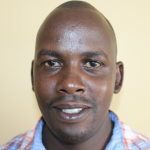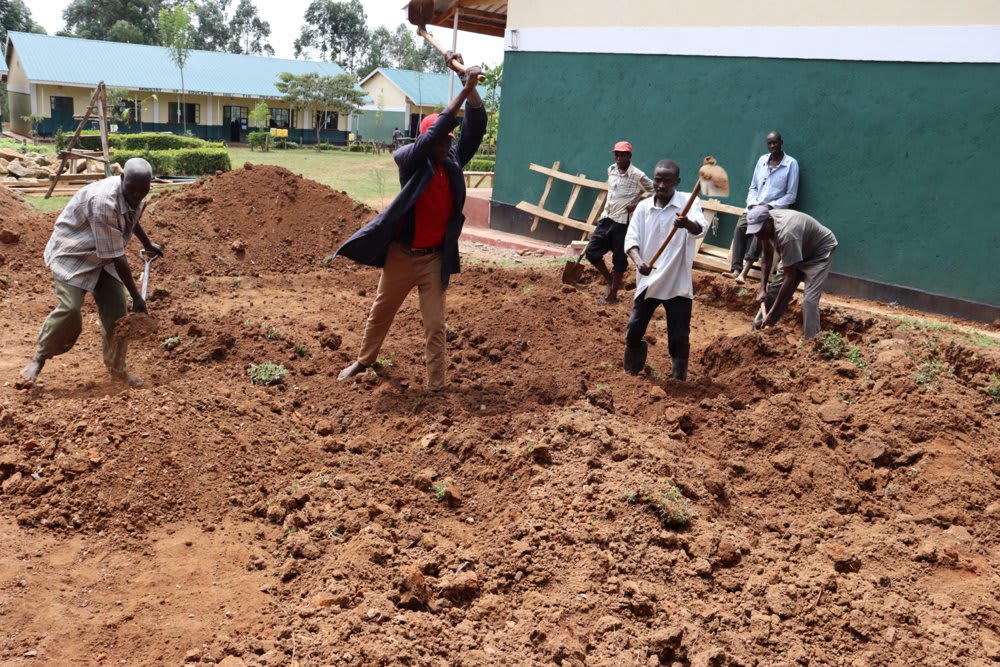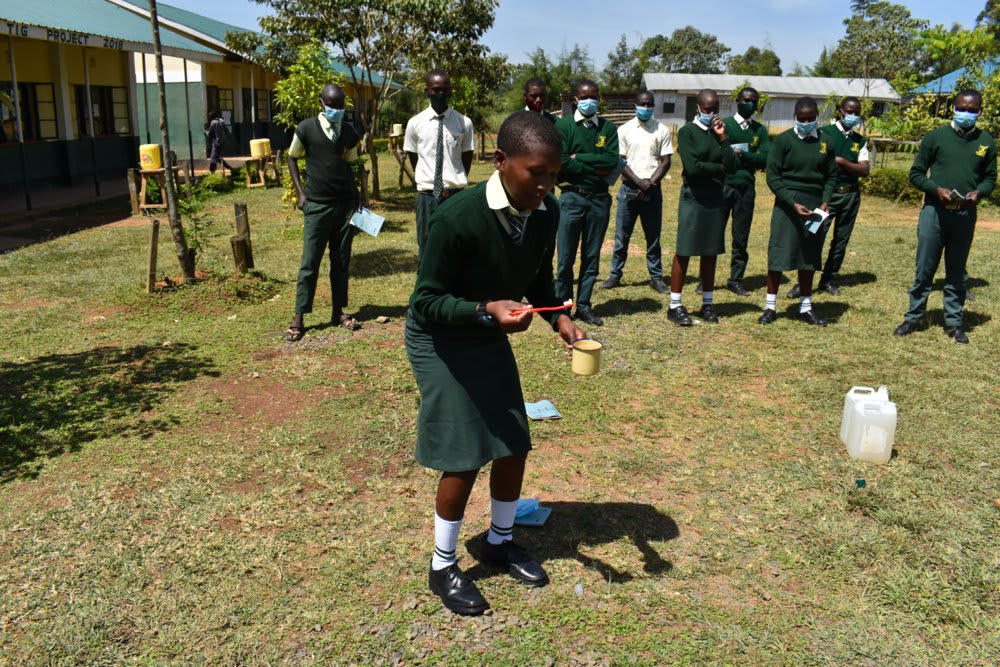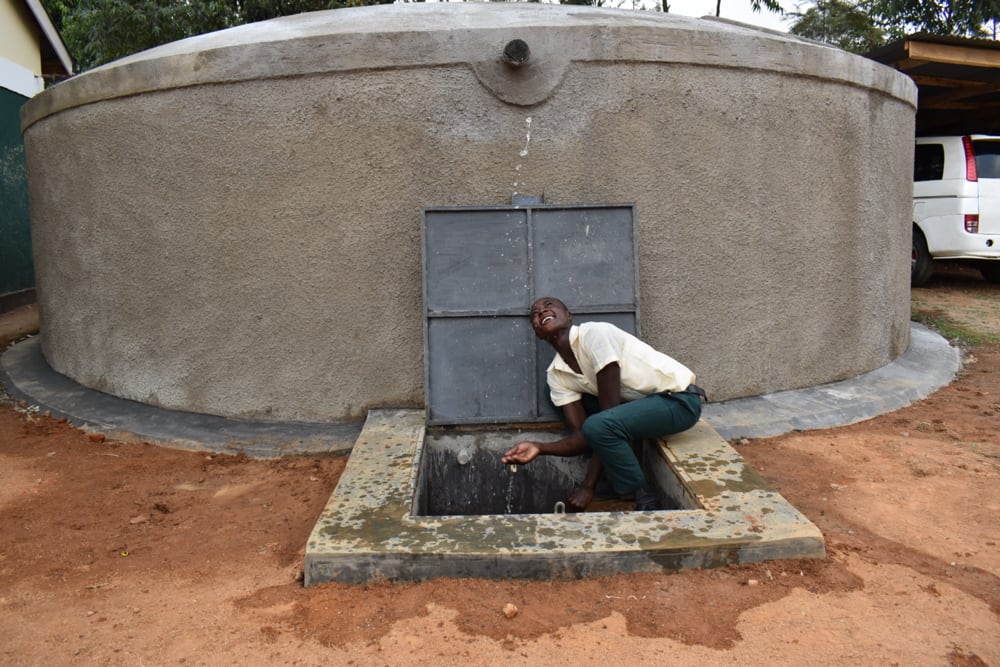Friends School Manguliro Secondary was established in 2013 by the surrounding community members and the Quaker Church to give a closer, more affordable secondary education option for students in the area. The school began with just 12 students and 2 classrooms on loan within the primary school's compound - 1 for students, and 1 for a staffroom. Since then, the secondary section has acquired 2 hectares of land and all of their own learning facilities to host its 273 students and 23 teachers and staff.
What the school has not acquired, however, is enough clean water for their school's daily needs.
The school patches together several different water sources in an attempt to cover all of their drinking, cooking, and cleaning needs, but they are still falling short. Their main source of water is a hand-dug well on school grounds that only gives water seasonally and is easily dirtied the more it is used.
To fetch water, students must lower a bucket on a rope into the well, submerge it at the bottom, and then haul it back up. The container and rope bring dirt back down with every haul, and the mud at the bottom of the well is also stirred up each time. The process is tiring and time-consuming, made even more frustrating by the congestion of students when they all need water at once during their scheduled breaks and lunch.
Since students' arms often tire out after a few pulls of the bucket, they typically work in pairs to carry their full containers back to the kitchen, further slowing down the process of water collection.
Another small dent in the school's water needs comes from a tiny plastic rain tank on campus. At just 5,000-liters capacity, it empties quickly and frequently and offers little relief.
When both of these sources are still not providing enough water, students are asked to carry water from home, and they are sent out to a spring in the community. These trips waste a lot of valuable class time, and students come in already too tired to focus. Combined with the absenteeism due to waterborne illnesses students catch from drinking the dirty well water, their academic performance is being dragged down.
Even though some of the water students fetch starts out clean, dirty containers and other contaminated sources jeopardize everyone's health when the water is combined for use back at school. There is no method for treating the water students collect. According to Deputy School Principal Mr. John Wekesa, there was a time recently when most of the students in the school were diagnosed with typhoid due to the school water.
"When there is no water in our tank, I do prefer not to drink water from the well after a break because when students constantly draw water from the water point, it gets dirty," said Denis, a student at the school.
Denis also expressed his frustration at how the very process that lets you fetch water by pulling the bucket up from the rope also dirties the water due to the rope and bucket dropping back down into the water. Contamination, the students know, is unavoidable at this source.
"The problem of insufficient water in the school doesn't affect students alone," said Mr. Wekesa.
"Also us as teaching staff - we do face a lot of challenges especially after the tea break and after lunch where students have to take much time scrambling for water to wash their utensils. They end up being late to class. If [you are teaching] the next lesson after the tea break or lunch break, you may run short of time because students take time to settle."
What We Can Do:
Rain Tank
A 75,000-liter rainwater catchment tank will help alleviate the water crisis at this school. The school will help collect the needed construction materials such as sand, bricks, rocks, and water for mixing cement. We will complement their materials by providing an expert team of artisans, tools, hardware, and the guttering system. Once finished, this tank will begin catching rainfall that will be used by the school’s students and staff for drinking, handwashing, cooking, cleaning, and much more.
We and the school strongly believe that all of these components will work together to improve standards at this school, which will help lead to better student academic performance and will help to unlock the potential for these students to live better, healthier lives.
Handwashing Stations
There are currently just 2 handwashing stations attached to the latrines for students to wash their hands after using the latrines or before eating lunch. These stations are overcrowded, however, and often lack the water to make them functional since the school cannot spare it to keep them full.
The student health club will oversee the 2 new handwashing stations we will provide, and make sure they are kept clean and in working condition. The club leaders will fill the handwashing stations with water daily and make sure they are always supplied with a cleaning agent such as soap or ash.
VIP Latrines
2 triple-door latrine blocks will be constructed with local materials that the school will help gather. 3 doors will serve the girls while the other 3 will serve the boys. All of these new latrines will have cement floors that are designed to be easy to use and to clean. And with a rain tank right on school property, there should be enough water to keep them clean.
Training on Health, Hygiene, COVID-19, and More
We will hold a 1-day intensive training session with students, teachers, and parents. This training will cover a wide range of topics including COVID-19 symptoms, transmission routes, and prevention; personal and environmental hygiene; and the operation and maintenance of the rain tank, latrines, and handwashing stations. There will be a special emphasis on handwashing.
Our team of facilitators will use a variety of methods to train, including participatory hygiene and sanitation transformation, and asset-based community development. We will initiate a student health club, which will prepare students to lead other pupils into healthy habits at school and at home. We will also lead lectures, group discussions, and provide illustrative handouts to teach health topics and ways to promote good hygiene practices within the school including handwashing and water treatment. We will then conduct a series of follow-up trainings before transitioning to our regularly scheduled support visits throughout the year.

 Rainwater Catchment
Rainwater Catchment
 Rehabilitation Project
Rehabilitation Project















































